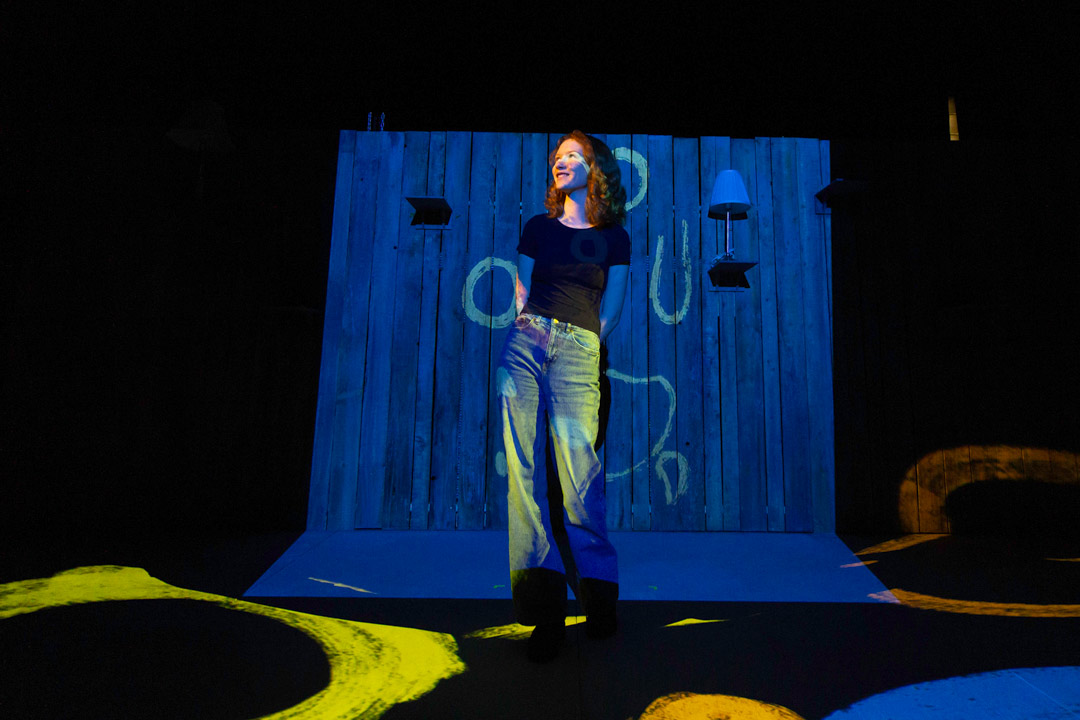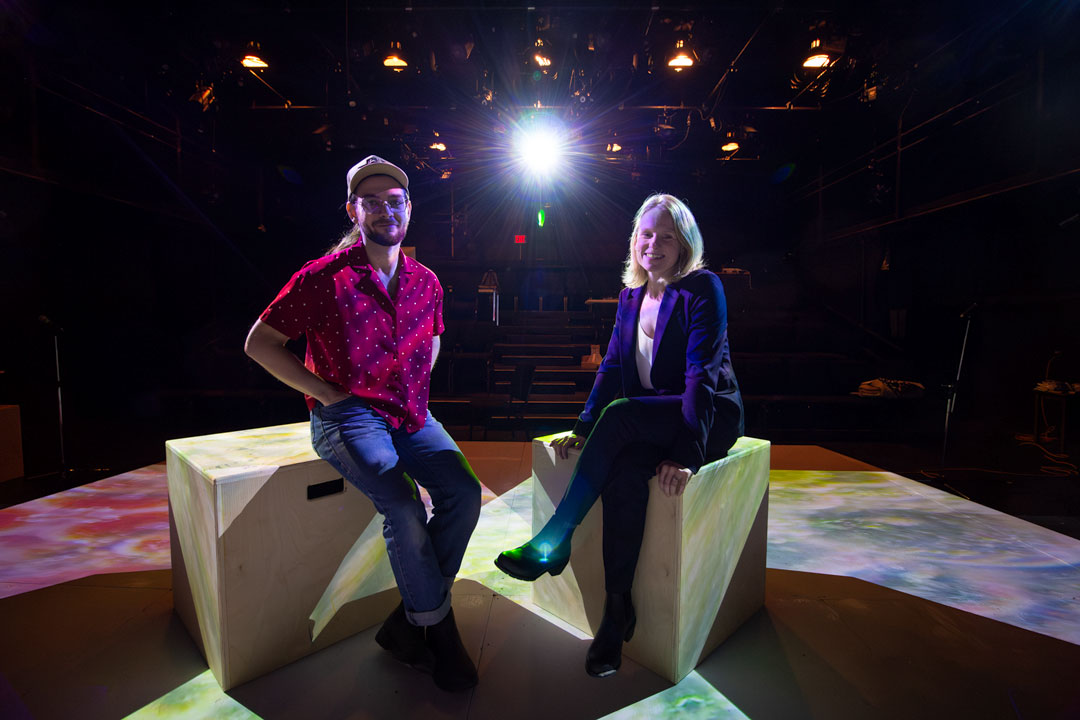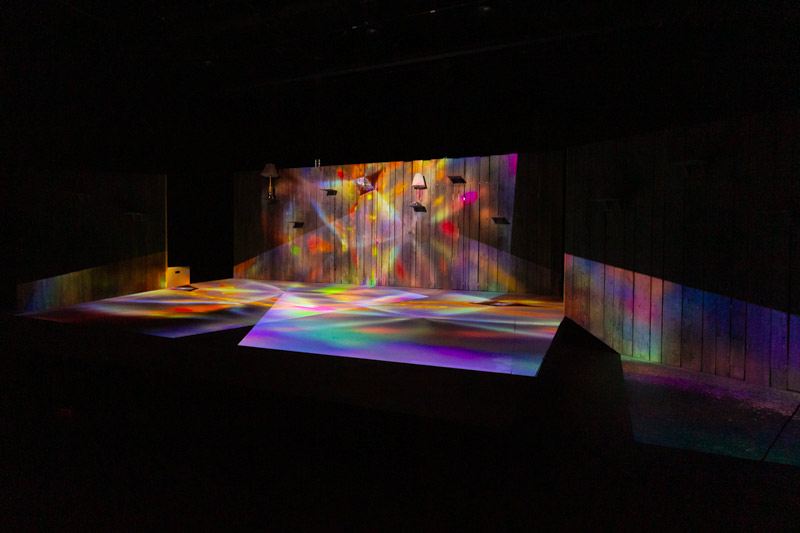
Art of the mind: USask students blend theatre, visual arts in new class
For Greystone Theatre’s Brainstorm, actors and animators are exploring the mind together
By Chris Putnam
Swirling colours, crisscrossing patterns, flashes of noise and light—what would we see if we could view the workings of another person’s mind?
Students in the University of Saskatchewan (USask) School for the Arts are part of a project this term that disrupts the boundaries between the performing and visual arts.
“We’ve been experimenting with lots of crazy stuff,” said fourth-year USask studio art student Asia Wills. “We’re dropping paint into liquid and filming what it does, making animations, doing 3D renders, doing a lot of digital alterations to videos.”
Wills and the other students in a new course called Drama 498: Applied Collaborative Interdisciplinary Creation are working closely with the cast and crew of Brainstorm, Greystone Theatre’s Feb. 12–15 production, to create moving images that will be projected during each performance.
800jpg

“Our goal is kind of mirroring what’s happening onstage,” said Wills, whose specialty is drawing and animation and who has never taken a drama class previously.
Written by Ned Glasier, Emily Lim and Company Three, and directed by School for the Arts assistant professor Shannon Blanchet, Brainstorm is a theatrical investigation of the human brain. It was originally created by a United Kingdom-based company in collaboration with neuroscientists. The Greystone Theatre production incorporates the personal experiences of the 12 USask actors performing in the show.
“This (498) class has been very collaborative. We are working closely with the drama class and watching them, taking inspiration from what they do and using that inspiration to make our own visual pieces, and just doing a back and forth between that class and ours,” said Wills.
Blanchet and sessional lecturer Jesse Fulcher Gagnon—the instructor of Drama 498—dreamed up the new course last year while the former drama, music, and art and art history departments were in the process of merging to create the School for the Arts in the College of Arts and Science.
“Both of our minds were going in the same direction: looking at finding ways to have more interdisciplinary and collaborative classes with this big change happening in the university,” said Fulcher Gagnon (BFA’15, MFA’22), who has degrees in both drama and studio art from USask.
Faculty and staff in the new school have been eager to create a shared culture among its students. Blanchet and Fulcher Gagnon are also keenly aware that working as a full-time artist in today’s world requires learning skills across many disciplines and media.
“My own career—technically I come from theatre, but I worked in film and television and video games, not just as a performer but as a producer. So you become in that sense a bit of a chameleon. And I saw that reflected in Jesse’s work and in Jesse’s background,” said Blanchet.

This year’s production of Brainstorm offered the perfect companion to the new course. Projected videos and images are not unusual in live theatre, but they are normally carefully planned at the start of production by the director and a projection designer.
In Drama 498, the students were set loose to create video art informed by what they saw onstage at each Brainstorm rehearsal. Their in-progress videos were then shown to the actors, who took inspiration from them to refine their own performances.
“It’s something quite different—something that we’d never even heard of before we sort of imagined it up on our own,” said Fulcher Gagnon.
The process involves a lot of risk for the actors and visual artists, who have put deeply personal expressions on display to inspire their fellow students, and for the director, who can’t be sure what the show will look like until everything comes together near the end.
That’s just the way Blanchet wants it.
“If we can’t experiment and push ourselves into unknown places in the context of a university theatre, I’m not sure why we’re here,” she said.
The physical set for Brainstorm, designed by associate professor Carla Orosz, is minimal: some wall panels, some lamps and a few wooden boxes. The projections made by the students will supply much of the colour and movement seen by audiences.
The videos are abstract, not literal, depictions of the action onstage. If they represent something, it’s the performers’ subconscious minds.
“Hopefully at some point the audience feels like they see the inside of a performer’s mind, and understands how they’re feeling or what they’re perceiving or what their brain is processing in that moment,” said Blanchet.
800jpg

Once Brainstorm wraps up, the Drama 498 students will continue to work on their video pieces until they are installed at an exhibition in early April.
“They’re all making some pretty amazing stuff. I’m so excited for people to see what they’re doing for the play and then where it grows from there for their final exhibition. I think that by the time we get there, there’s going to be some pretty incredible video work that’s been created,” said Fulcher Gagnon.
Wills said she is nervous but excited to see the final result of what she and the other students have been making.
“It’s been a ride just learning to not be afraid of what I’m going to create—just throwing it out there and experimenting.”
Together we will support and inspire students to succeed. We invite you to join by supporting current and future students' needs at USask.


